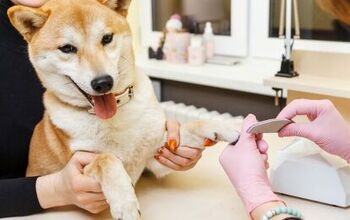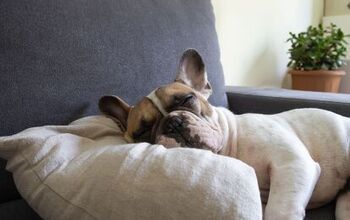How to Properly Disinfect Dog Bowls

“Gross! What is that? I didn’t feed him that!?!” This is the reaction of many dog owners as they look into their dog’s dirty food and water bowls. Is it slobber? Is it food particles? Is it… something else? At some point, you just have to stop trying to guess and focus on getting the bowl clean.
It’s no joke – dirty dog bowls can lead to bacteria and germs that can make your dog sick. Roll up your sleeves and hold your breath, because we’re going to tell you how to properly disinfect dog bowls.
Related: Pros And Cons Of Continuous Water Fountains For Pets
How Often to Wash Dog Bowls
Generally, you should to wash your dog’s food and water bowls after every use. While this may seem excessive, imagine treating yourself the same way and eating every meal out of an unwashed dish. Once again, gross! If you haven’t been cleaning your dog’s food and water bowls regularly, it’s never too late to start. On cheaper bowls made of plastic, it’s not uncommon to find mold growth if you’ve let them sit out long enough. It’s time to throw those bowls out and buy new bowls for a fresh start.
Related: Upscale Dog Bowls Let Fido Chow Down Like A Posh Pooch
What to Use to Properly Disinfect Dog Bowls
You’ll want to use a cloth or sponge that is only used for your dog’s bowls. Dish soap, water and some elbow grease, along with a thorough rinse, will get the bowls clean. If your dog’s bowls are stainless steel, you can clean them in the same manner but avoid harsh chemicals and antibacterial products to prevent rusting. Running them through a cycle in the dishwasher is also an excellent way to keep your dog’s food and water bowls clean.
Even if you stay on top of washing the dish after every meal, bacteria can remain. In fact, studies show that even a trip through the dishwasher will leave a significant number of bacteria behind. For this reason, it is recommended that you take the time to fully sanitize your dog’s bowl once a week. The process is quick and easy, requiring nothing more than bleach and water. Mix ½ cup of regular bleach into 4 litres of water. Allow your dog’s dish to soak in this mixture for approximately 10 minutes, giving it time to work its magic. When the time is up, rinse it thoroughly with fresh water to remove all bleach and allow it to air dry.
Hand Washing vs. Machine
When it comes to sanitizing dog bowls, the dishwasher wins. While hand washing with soap and hot water certainly will get the bowls clean, the dishwasher takes it a step further. Most bacteria that get collected on the bowls require scalding hot water at 140° Fahrenheit to fully remove and kill it. If you try to attempt to wash your dog’s bowls by hand at this temperature you’ll get burned. Don a couple of pairs of rubber gloves if you’re sans dishwasher, and crank that hot water!
Removing Dry, Caked on Food
If it has been a little bit since you last cleaned your dog’s food dish, you may have some food remnants that have been allowed to harden on the dish making it difficult to wash them off. You may be able to loosen this stuck on food by scrubbing it with a little extra effort. However, if your dog’s dish is stainless steel, this heavy scrubbing may also cause scratches, destroying the surface of their dish. Instead, give your dog’s dish the opportunity to soak in a sink of hot soapy water. As the food softens, it will be much easier to wipe the bowl clean.
Importance of Food Mats
Dog placemats aren’t just decorative – they’re beneficial when it comes to cleanliness. Most dogs eat their food and drink water without giving a second thought to good manners. Unless they are dainty eaters that never drop a morsel or a drop of water outside of their bowls, you’ll want to provide food mats for your dog. Food mats catch whatever spills over the edge of the bowls in addition to any drool or slobber. Some food mats have a raised edge to assure that the food never touches the floor. This prevents your dog from eating directly off of the floor and congesting harsh chemical residue that are in floor cleaning products. It also makes your life easier, since it is easy to clean up leftover food. You will want to give the food mat a good hand washing or wipe on a daily basis to avoid bacteria growth.
When to Replace Your Dog’s Dish
Each time that you clean your dog’s dish, take a moment to look it over carefully for signs of wear and tear including scratches, groves, or deep bite marks. These spots are often difficult to clean and can quickly turn into a breeding ground for bacteria. If you notice that your dog’s dish is starting to show its age, it’s time to look at getting a replacement.
While stainless steel dog dishes may not offer as many fun colors and patterns, they are often the go-to according to veterinarians and other dog professionals. This is largely due to the fact that they are easy to clean, dishwasher friendly and non-porous. They are also extremely durable, meaning that you are less likely to run into problems with a dish cracking or breaking if it’s knocked around or dropped. This is especially important if your dog tends to be a chewer, as they may chew pieces off a plastic or silicone dish which, when ingested, can lead to complications like an intestinal blockage.
This doesn’t necessarily mean that stainless steel is the perfect choice for every dog. If you have a dog that is skittish, fearful or shows signs of anxiety, they may be bothered by the noise that a meal dog food bowl makes. This could lead to avoidance, causing your dog to eat very little or even skip meals altogether. Your dog’s health is, of course, the top priority. If this is the case, consider trying a ceramic or plastic dish. But know that you may have to replace your dog’s dish more frequently.
Keep your dog healthy and prevent him from coming into contact with bacteria by cleaning dog bowls after every use. And remember to inspect your dog’s bowls for scratches. Deep scratches can be a home for bacteria that can make your dog sick. Replace your dog’s food and water bowls when necessary to keep your dog healthy and happy.

More by Lori Ennis























